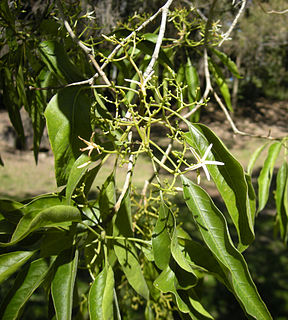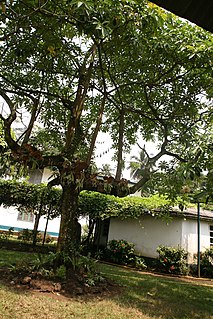
Apocynaceae is a family of flowering plants that includes trees, shrubs, herbs, stem succulents, and vines, commonly known as the dogbane family, because some taxa were used as dog poison. Members of the family are native to the European, Asian, African, Australian, and American tropics or subtropics, with some temperate members. The former family Asclepiadaceae is considered a subfamily of Apocynaceae and contains 348 genera. A list of Apocynaceae genera may be found here.

Alstonia is a widespread genus of evergreen trees and shrubs, of the family Apocynaceae. It was named by Robert Brown in 1811, after Charles Alston (1685–1760), professor of botany at Edinburgh from 1716 to 1760.

Alstonia scholaris, commonly called blackboard tree or devil's tree in English, is an evergreen tropical tree in the family Apocynaceae. It is native to southern China, tropical Asia and Australasia, it is a commonly planted ornamental plant in these areas. It is a toxic plant, but traditionally it is used medicinally for myriad diseases and complaints.

Alstonia constricta, commonly known as quinine bush or bitterbark, is an endemic Australian endemic shrub or small tree of the family Apocynaceae.

Boonein is an iridoid isolated from Alstonia boonei, a medicinal tree of West Africa.

Loganin is one of the best-known of the iridoid glycosides. It is named for the Loganiaceae, having first been isolated from the seeds of a member of that plant family, namely those of Strychnos nux-vomica. It also occurs in Alstonia boonei (Apocynaceae), a medicinal tree of West Africa and in the medicinal/entheogenic shrub Desfontainia spinosa (Columelliaceae) native to Central America and South America.

Echitamidine is an indole alkaloid isolated from Alstonia boonei. Its laboratory synthesis has been reported.

Nareline is a bio-active alkaloid isolated from Alstonia boonei, a medicinal tree of West Africa.

Alschomine is an indole alkaloid first identified in the leaves of Alstonia scholaris in 1989.

Picrinine is a bio-active alkaloid from Alstonia boonei, a medicinal tree of West Africa.

Scholarine is an alkaloid isolated initially from Alstonia scholaris by Banerji and Siddhanta. Subsequently, it was obtained from the West African tree Alstonia boonei. The derivative N-Formylscholarine has been isolated from the fruit pods of Alstonia scholaris.

Picralinal is a bio-active alkaloid from Alstonia scholaris, a medicinal tree of West Africa.

Rhazine is an alkaloid isolated from Alstonia boonei, a tree of West Africa.

Scholaricine is an alkaloid that has been isolated from Alstonia boonei, a tree of West Africa.

Villalstonine is a bisindole alkaloid isolated from Alstonia with in vitro antiplasmodial activity.

Macrocarpamine is an Alstonia alkaloid with antiplasmodial activity.

Vinorine is an indole alkaloid isolated from Alstonia.

Alstonine is an indoloquinolizidine alkaloid and putative antipsychotic constituent of various plant species including Alstonia boonei, Catharanthus roseus, Picralima nitida, Rauwolfia caffra and Rauwolfia vomitoria. In preclinical studies alstonine attenuates MK-801-induced hyperlocomotion, working memory deficit and social withdrawal. It also possesses anxiolytic-like effects in preclinical studies, attenuates amphetamine-induced lethality and stereotypy as well as apomorphine-induced stereotypy, and attenuates haloperidol-induced catalepsy. These effects appear to be mediated by stimulation of the 5-HT2C receptor. In addition, alstonine, similarly to clozapine, indirectly inhibits the reuptake of glutamate in hippocampal slices. Unlike clozapine however, the effect of which is abolished by the D2 receptor agonist apomorphine, alstonine requires 5-HT2A and 5-HT2C receptors to produce this effect, as it is abolished by antagonists of these receptors. Also unlike clozapine, alstonine lacks pro-convulsant activity in mice.
Alstonia boonei is a very large, deciduous, tropical-forest tree belonging to the family Apocynaceae. It is native to tropical West Africa, with a range extending into Ethiopia and Tanzania. Its common name in the English timber trade is cheese wood, pattern wood or stool wood while its common name in the French timber trade is emien.

Alstonia congensis, is a tree within the Apocynaceae family and one of two African species within the Alstonia genus, the other being the Alstonia boonei De Wild. Both have similar morphological characteristics.



















